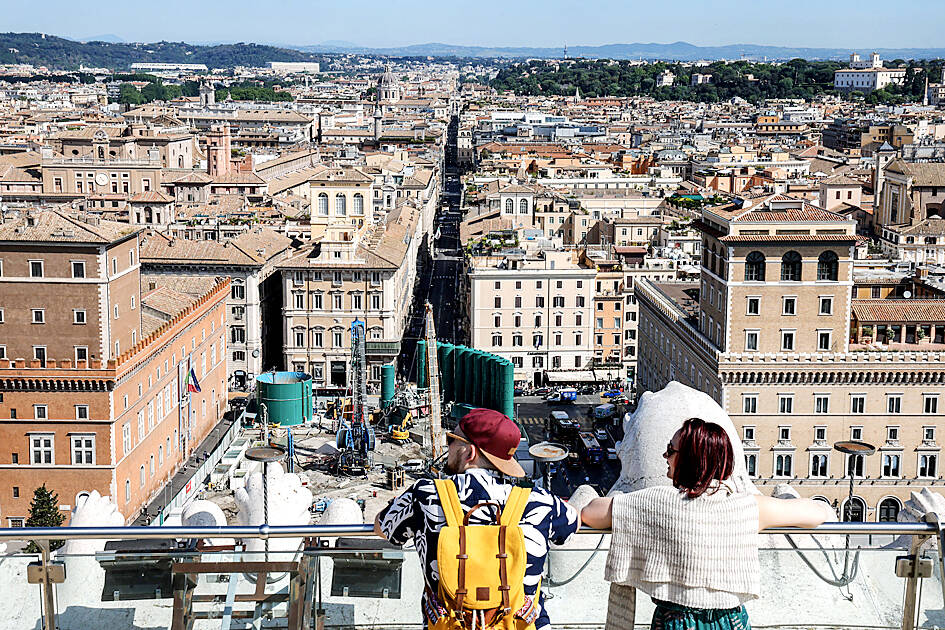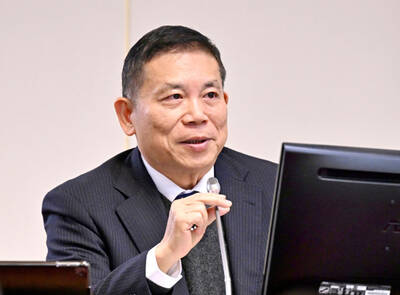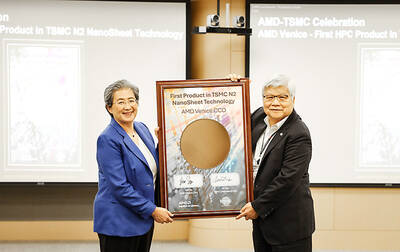Having made property investments in Milan, Italy, Italian architect Giuseppe Pezzano is now looking for a place in Rome to set up a second home and studio, as the capital’s underdeveloped real-estate sector draws fresh attention.
Pezzano’s property hunt highlights a wider shift that has put Rome in the sights of professional real-estate investors, after the Milan area took more than half of their investments in Italy in the past five years, data by Scenari Immobiliari think tank showed.
Sky-high prices and judicial probes into the fast-tracking of building permits have put a brake on the market in Italy’s financial capital, just as public spending in Rome for the Roman Catholic Holy Year and a friendlier attitude from the local administration draw in investors spotting a bargain.

Photo: EPA-EFE
“In Milan, 400,000 euros [US$418,430] gets you an ugly one-bedroom, in Rome you can live in a late 19th-century building,” Pezzano said.
“Rome’s architecture, its open views and its people make it the world’s most beautiful city. I want a window that looks out onto that beauty. And I think I can find new clients there. Rome is on the cusp of an architectural renaissance.”
Rome accounted for 17 percent of all professional real-estate investments last year in Italy, up from an average of 11 percent over the 2020-2024 period, data by property services firm JLL showed.
Professional property investors poured 1.7 billion euros into Rome projects last year, double the 2023 figure. The Holy Year, which is forecast to add an extra 10 million tourist arrivals to last year’s 22 million record, has fueled up to 8 billion euros of public spending to refurbish central areas and strengthen infrastructure.
To promote urban renewal across a city dotted with ancient ruins and some of the world’s most spectacular churches and fountains, Rome in December last year approved new town planning rules, which it had last updated in 2008.
The city is also striving to narrow the gap with Italy’s more efficient financial capital and ease residents’ daily struggles with public transport, potholed roads and uncollected rubbish.
Global real-estate investment manager Hines is working to secure its first Rome project, after focusing on the north of Italy until now.
“We believe Rome has the potential to experience the real-estate renaissance that Milan has undergone over the past decade,” Hines Italy head Mario Abbadessa said.
The gap between the 12,000 to 14,000 euros per square meter commanded by an apartment in the center of Milan, and the 8,000 to 9,000 euros of an equivalent property in Rome is “excessive,” Abbadessa said.
Rome is also cheaper than other southern European capitals such as Lisbon or Athens.
The 2015 World Expo ushered in a property boom in Milan with house prices up 27 percent in 2014 to 2024 on average, or 52 percent in semi-central areas, consultancy PwC calculated.
By contrast, Rome’s house prices declined by 14.4 percent over the past decade, according to think tank Nomisma.
Investors see value. Rome accounts for the bulk of Czech firm CPI Property Group’s investments in Italy, which have reached 1.5 billion euros from 53 million in 2018, a person with knowledge of the matter said.
On a smaller scale, Rome projects worth 30 million euros make up more than half of Italian group Hera Holding’s property portfolio, up from one-fifth in 2018.
Rome City Councilor Maurizio Veloccia said that Rome has had to restore its credibility with investors.
Many Rome builders, often small, family-owned firms, did not survive the recessions Italy suffered from 2008 to 2013.
“And outsiders were not interested in stepping in because of the bureaucracy risk,” Veloccia said. “Projects stalled half-way, and this reflected badly with public opinion, reinforcing the idea that real-estate investments are a danger.”
Marking a shift in attitude, Rome reopened to the public its urban planning department, which had become digital-only during the COVID-19 pandemic.
To reduce risks and costs for investors faced with lengthy and uncertain approval processes, the administration boosted its decisionmaking powers. It also lifted restrictions, such as a cap of 60 rooms for hotels in the city center, and removed 700 buildings from a list of protected properties that hindered renovation.
“With the jubilee acting as a catalyst, Rome must now prove it can address the issues that have for so long held back real-estate investments,” Scenari Immobiliari director general Francesca Zirnstein said.
Some stranded construction projects are getting a second lease of life.
One example is the “Ex Fiera di Roma” site, a 76,000m2 former convention center area whose renovation has stalled for 20 years.
A fund backed by banks UniCredit and Illimity owns the site, and developer ARECneprix is turning more than half the area into buildings, mostly residential, including a portion of social housing. Social housing is key to Rome’s efforts to avoid following in Milan’s tracks, where residents are being priced out as wealthy foreigners making use of tax benefits flock in.
Rome’s size is seen as a further defense against gentrification.
“I don’t see Rome becoming a new Milan, it’s too big and full of families and students, not high-flying professionals,” Rome resident Paola Salvetti said.

Taiwan will prioritize the development of silicon photonics by taking advantage of its strength in the semiconductor industry to build another shield to protect the local economy, National Development Council (NDC) Minister Paul Liu (劉鏡清) said yesterday. Speaking at a meeting of the legislature’s Economics Committee, Liu said Taiwan already has the artificial intelligence (AI) industry as a shield, after the semiconductor industry, to safeguard the country, and is looking at new unique fields to build more economic shields. While Taiwan will further strengthen its existing shields, over the longer term, the country is determined to focus on such potential segments as

UNCERTAINTY: Innolux activated a stringent supply chain management mechanism, as it did during the COVID-19 pandemic, to ensure optimal inventory levels for customers Flat-panel display makers AUO Corp (友達) and Innolux Corp (群創) yesterday said that about 12 to 20 percent of their display business is at risk of potential US tariffs and that they would relocate production or shipment destinations to mitigate the levies’ effects. US tariffs would have a direct impact of US$200 million on AUO’s revenue, company chairman Paul Peng (彭雙浪) told reporters on the sidelines of the Touch Taiwan trade show in Taipei yesterday. That would make up about 12 percent of the company’s overall revenue. To cope with the tariff uncertainty, AUO plans to allocate its production to manufacturing facilities in

COLLABORATION: Given Taiwan’s key position in global supply chains, the US firm is discussing strategies with local partners and clients to deal with global uncertainties Advanced Micro Devices Inc (AMD) yesterday said it is meeting with local ecosystem partners, including Taiwan Semiconductor Manufacturing Co (TSMC, 台積電), to discuss strategies, including long-term manufacturing, to navigate uncertainties such as US tariffs, as Taiwan occupies an important position in global supply chains. AMD chief executive officer Lisa Su (蘇姿丰) told reporters that Taiwan is an important part of the chip designer’s ecosystem and she is discussing with partners and customers in Taiwan to forge strong collaborations on different areas during this critical period. AMD has just become the first artificial-intelligence (AI) server chip customer of TSMC to utilize its advanced

Chizuko Kimura has become the first female sushi chef in the world to win a Michelin star, fulfilling a promise she made to her dying husband to continue his legacy. The 54-year-old Japanese chef regained the Michelin star her late husband, Shunei Kimura, won three years ago for their Sushi Shunei restaurant in Paris. For Shunei Kimura, the star was a dream come true. However, the joy was short-lived. He died from cancer just three months later in June 2022. He was 65. The following year, the restaurant in the heart of Montmartre lost its star rating. Chizuko Kimura insisted that the new star is still down